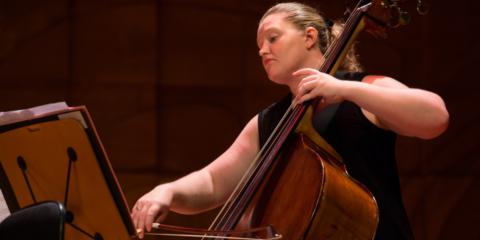Schubert Mass can be heard on Sunday 28 July at Melbourne Recital Centre and Thursday 1 August at Iwaki Auditorium, ABC Southbank Centre.
MCO: We have a feast of Schubert in this concert. The third Symphony, from 1815, places it chronologically around the time of Beethoven’s 8th Symphony. Beethoven and Schubert are the two major figures of the “late Classical”, but do musicians think of these composers as being similar or different? How do you think about this very early work of Schubert?
Emma: Both of the Schubert works in our program were composed in 1815, when he was only 18 years old. This was one of Schubert’s most prolific years as a composer, resulting in many works including his second and third symphonies, two full-scale masses and over 140 songs. What I find interesting about Schubert’s music is that he was not limited by one aesthetic. His third symphony is a clear example of Classical style whereas his setting of Goethe’s Erlkönig, composed in the same year, encapsulates the drama and expression of the Romantic era. There is little doubt that Schubert was influenced and inspired by Beethoven but he certainly wrote in his own style. His third symphony reveals the influence of Haydn, Mozart and earlier Beethoven symphonies with its bubbling energy, lightness and elegance. However, it is also clearly in Schubert’s distinctive voice with plenty of flair and spontaneity. Although Beethoven referred to his 8th symphony as his “little symphony” it is certainly not small in scope, exhibiting a range of dynamic expression and lyrical melodic content much more in keeping with Romantic style.
MCO: We are pretty excited to do our first ever choral performance as Melbourne Chamber Orchestra, with a terrific Melbourne choir, Polyphonic Voices. Lots of great composers wrote mass settings — how will audiences find that this Schubert Mass compares with other masses they might know?
Emma: It is a real thrill to be joining with Polyphonic Voices for this concert and presenting our first concerts with chorus. For many music lovers, mass settings have an immediate connotation of being works on a very grand scale, both in terms of length and orchestration. Schubert’s second Mass in G is more intimate and therefore very well suited to our forces. The scale of the work reflects the purpose for which it was written – Schubert composed the work for his home parish, scoring it for soprano, tenor and bass soloists, mixed chorus and strings. The work is a celebration of Schubert’s innate gift for melodic invention and is full of beautifully understated melodies that serve the religious text. In his writing, Schubert highlights his awareness of what came before him, while also continuing to innovate his own musical style. Some movements hark back to the Baroque era, employing French Overture style, fugal textures and ostinato bass lines (where a short figure is repeated). Schubert also moves toward Romanticism with his lyrical melodic style and in his more fluid treatment of harmony.
MCO: Perhaps a bit unusually, this program starts with a concerto by Bach, with our Artistic Director William Hennessy as a soloist. Where does this concerto and its style fit into the concerto tradition?
Emma: The concerto genre was established in the Baroque era and existed in two main forms – concerto grosso, which featured a group of soloists, and the solo concerto. Italian composers Vivaldi, Corelli and Torelli were the first important composers in both concerto formats. Bach’s two extant concertos for solo violin reveal his awareness and admiration for the work of these early concerto composers and are quite Italian in style and structure, using the three movement model (fast-slow-fast). Bach blended this Italian style with his own mastery of harmony and form and the scope of his violin concertos undoubtedly influenced the development of the genre. Bach is widely known as a keyboard virtuoso but he was also a highly skilled violinist. His son C.P.E. Bach noted that his father played the instrument with a pure and penetrating tone. This is reflected in his writing for the instrument – the concerto is an absolute tour de force for the violin and demands significant facility and stamina from the soloist. The outer movements are overflowing with energy and excitement and are full of dialogue between the soloist and ensemble. But it is the slow movement that is particularly special. An undulating bass line underpins an emotive and languorous solo voice and provides a complete change of atmosphere.

